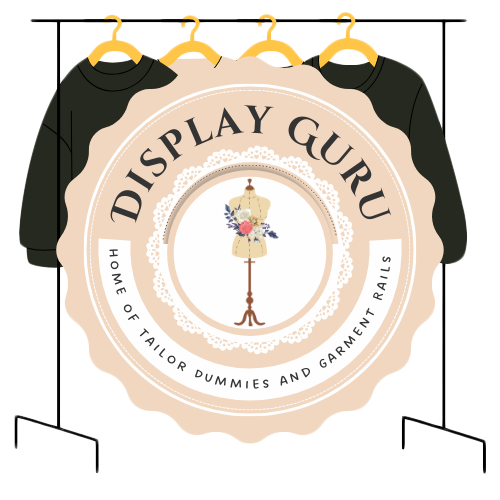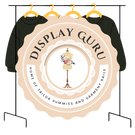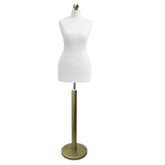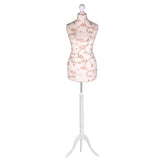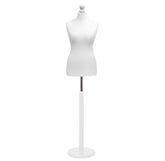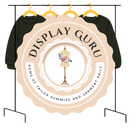Adjustable Mannequin for Sewing: Your Ultimate Fitting Guide
Why Every Serious Sewer Needs an Adjustable Mannequin
Imagine trying to bake a cake without a proper cake pan. You pour the batter onto a flat baking sheet, hoping for the best, but it spreads unevenly and doesn't rise quite right. Frustrating, right? Sewing without a dress form can feel similar. You carefully cut and stitch, only to find the finished garment doesn't fit properly. An adjustable mannequin for sewing solves this problem, acting as a personalized, 3D "cake pan" for your projects. It gives you a changeable form that allows for continuous adjustments, ensuring a perfect fit throughout the sewing process.
Think about the complexities of fitting a bodice, for example. A flat pattern can’t perfectly capture the curves and contours of a real body. With an adjustable mannequin, you can fine-tune the form to mirror your own unique shape or that of your client, ensuring a comfortable and flattering fit. This allows for precise adjustments throughout the process, reducing those frustrating moments of discovering fit issues after the garment is complete. Unlike static dress forms stuck in a single size, adjustable mannequins offer the flexibility to work on multiple sizes or adjust for weight fluctuations.
This adaptable nature is especially helpful for those involved in the UK fashion industry, a major contributor to the UK economy. This sector supports around 1.3 million jobs – that's 1 in every 25 jobs in the country – and contributes over £23 billion in tax revenue. This thriving industry fuels the demand for adaptable tools like adjustable mannequins, making them valuable assets for both professionals and home sewers. Discover more insights into the UK fashion industry. This strong industry presence also means easy access to a variety of adjustable mannequin options.
From Frustration to Fit: Real Sewing Success Stories
Beyond the practical benefits, adjustable mannequins can truly transform the sewing experience. Sewers who use these tools often share stories of increased confidence and rediscovered enjoyment in their craft. One home sewer shared how an adjustable mannequin helped her finally master sleeve fitting, turning a previously dreaded task into a satisfying achievement. Another sewer, who runs a small alterations business, reported doubling her productivity after investing in an adjustable form.
These stories show how an adjustable mannequin can be a real game-changer for everyone, from beginners learning the ropes to seasoned professionals. They empower you to create garments with a professional finish, spend less time on alterations, and simply enjoy the process more. This translates to a more rewarding sewing journey, focusing on the creative joy of making beautiful clothes. Investing in an adjustable mannequin is an investment in your skills and your passion.
Decoding the Different Types: Which One Fits Your Style
Choosing an adjustable mannequin can feel a bit like Goldilocks trying different porridges – some too hard, some too soft. With mannequins, some have too many dials, some not enough. The trick is finding one that's just right for your sewing needs. This infographic shows how to achieve a perfect fit with an adjustable mannequin.
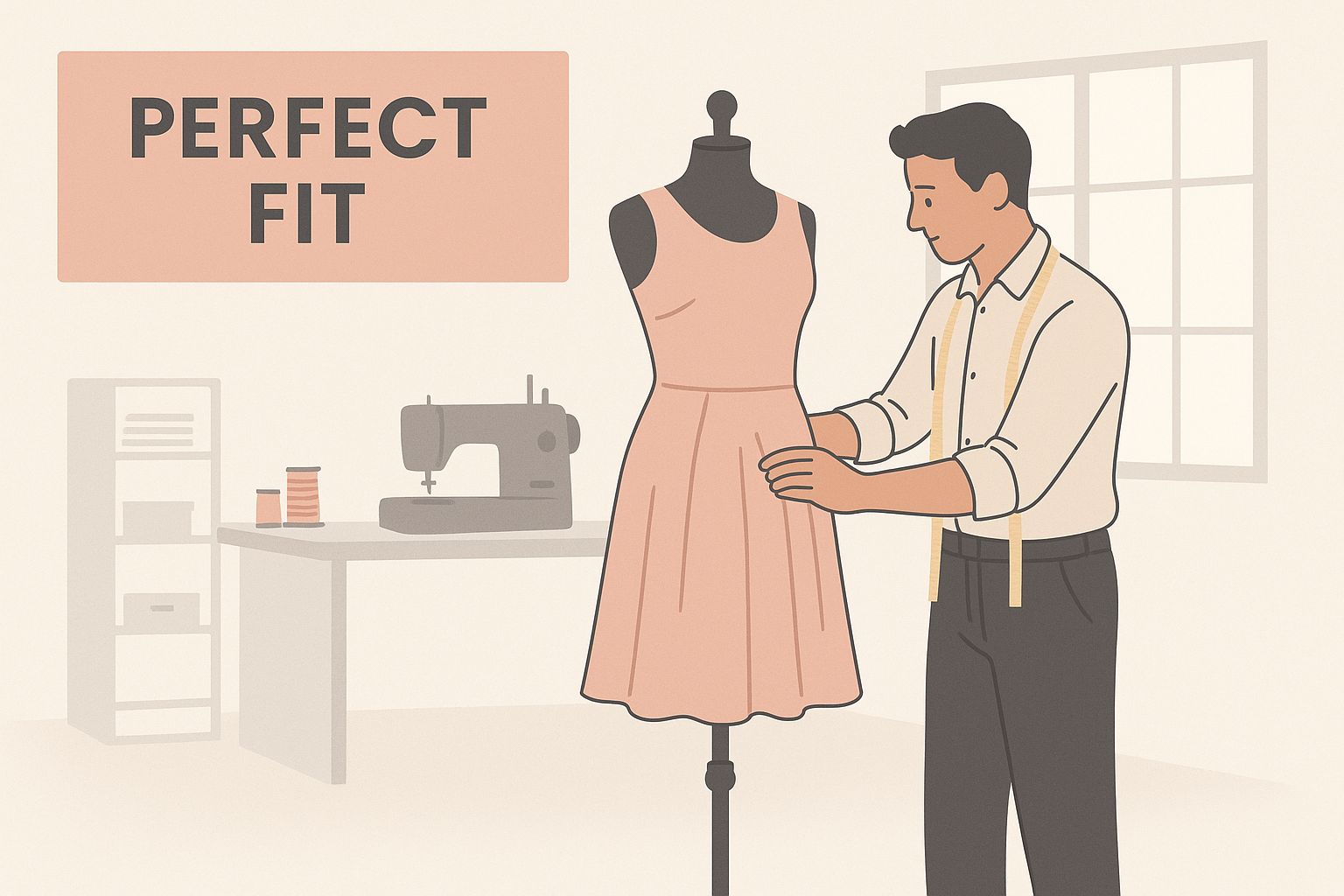
The infographic illustrates how adjusting the mannequin to your measurements results in a perfectly fitting garment. It connects the dots between a well-adjusted mannequin and the desired result: clothes that fit like a dream.
From Basic to Professional: A Spectrum of Choices
Adjustable mannequins run the gamut from simple and affordable to complex and professional. Think of it like a kitchen – some people need basic tools, while others want every gadget available. A tabletop mannequin is perfect for small spaces and basic alterations, like adjusting a hem or taking in a seam. It offers basic bust, waist, and hip adjustments, making it suitable for blouses, dresses, and jackets.
But if you're working on more involved projects, a full-torso mannequin is worth considering. Like upgrading from a bicycle to a car, it provides a more complete picture, extending down to the hips or even including partial legs. This is ideal for fitting skirts, trousers, or even lingerie. These mannequins also often have a wider range of adjustments to fit diverse sizes and shapes.
Navigating the Nuances: Dial Adjustment vs. Pinnable Forms
Another key difference is how you adjust the mannequin. Some use dial adjustments, allowing for precise control over bust, waist, and hip measurements with numbered dials. This is great for repeatability, especially if you sew for others or make multiple garments in the same size. Imagine sewing bridesmaid dresses – a dial-adjustment mannequin allows you to easily switch between sizes, ensuring a perfect fit for each person. Display Guru offers some excellent examples of these types of mannequins.
Pinnable mannequins offer a more hands-on approach. Made from padded material, you customize the shape by pinning fabric directly onto the form. This is like sculpting – you mold the mannequin to perfectly match your desired shape. This flexibility is invaluable for draping and creating custom patterns.
To help you visualize the differences, here’s a comparison table:
Comparison of Adjustable Mannequin Types
| Type | Adjustment Range | Price Range | Best For | Key Features |
|---|---|---|---|---|
| Tabletop | Limited bust, waist, hip | $50 - $150 | Basic alterations, small spaces | Compact, affordable |
| Full-Torso | Wider bust, waist, hip; sometimes back and height | $100 - $300+ | More complex projects, fitting full garments | More adjustability, partial or full legs available |
| Dial Adjustment | Precise, numbered adjustments | $150 - $400+ | Repeatability, sewing for others | Easy size changes, accurate fitting |
| Pinnable | Customizable shape through pinning | $80 - $200 | Draping, custom patterns | Flexible shaping, unconventional designs |
This table highlights the key features of each type, making it easier to choose the right one for your specific needs. As you can see, each style has its own strengths, catering to different sewing preferences and project types.
Both dial adjustment and pinnable mannequins have their advantages. Ultimately, the best choice depends on your sewing style and what you're making. Finding the right adjustable mannequin is a personal journey, a bit like finding the perfect pair of shoes.
Features That Actually Matter (And Ones That Don't)
Let's be honest, some mannequin features look amazing on paper but end up being more hassle than they're worth. Think of that pasta maker you bought that's now gathering dust – some tools just don't live up to the hype. After talking with many sewers, from fashion students at Central Saint Martins to professionals altering wedding dresses in Mayfair, a clear picture emerges of what truly matters.
The Heart of the Matter: Adjustment Mechanisms
The core function of an adjustable mannequin lies in its adjustability. But the quality of that adjustment mechanism is more important than the sheer number of adjustment points. Imagine a bike with 20 gears but a sticky shifter – frustrating, right? Similarly, a mannequin with tons of dials but stiff, unreliable adjustments will quickly become a nuisance. Smooth, effortless adjustments are key. You want a mannequin that responds intuitively, allowing for seamless transitions between sizes and shapes. This makes fitting a breeze, not a battle.
Having trouble visualizing? Think of those smooth camera tripods that glide into position with the slightest touch – that's the kind of responsiveness you should look for in a mannequin's adjustment dials.
Built to Last: Sturdy Construction and Quality Materials
Durability is essential. A wobbly mannequin is like a shaky camera – it undermines your entire process. Look for robust construction and quality materials. A solid base keeps things stable, preventing tipping, especially with heavier garments. Durable materials ensure your mannequin can withstand years of use, pinpricks, and adjustments. This means long-term value and reliability, making it a smart investment.
Consider the wear and tear a dress form endures – constant adjustments, pins stuck in, fabric draped over it. It needs to be tough!
Beyond the Bells and Whistles: Practicality Over Flash
Many manufacturers pack their mannequins with features that sound impressive but don't add much practical value. It's like buying a car with a sunroof in rainy London – nice, but not necessary. Collapsible shoulders are generally invaluable, allowing you to easily dress and undress the form. Other additions, like intricate markings or specialized accessories, might be less helpful for your sewing needs. Focus on features that solve your fitting challenges and improve your workflow.
Before you get swayed by fancy extras, ask yourself: "Will I actually use this, or will it just complicate things?"
The increasing popularity of home sewing and professional garment production in the UK is driving sales of flexible sewing tools like adjustable mannequins. This is part of a larger trend, reflected in the UK sewing machine market, valued at USD 116.7 million in 2024, and projected to keep growing. This growth reflects a wider expansion within the sewing-related equipment sector. Discover more insights into the UK textile market. This growing market offers more choices for sewers investing in quality equipment.
Choosing Wisely: Assessing Quality and Avoiding Buyer’s Remorse
When choosing an adjustable mannequin, look for signs of quality. Smoothly operating dials, sturdy construction, and a stable base are good indicators. Avoid mannequins with loose parts, flimsy materials, or jerky adjustments. These often signal potential problems. A well-made mannequin should feel like an extension of your skills, empowering you to achieve a perfect fit every time. Investing in a quality mannequin prevents future headaches and ensures years of happy sewing.
Think of it like choosing a good pair of scissors – you can feel the quality in the smooth action and solid build. The same applies to a mannequin.
Finding Your Perfect Match: A Practical Selection Guide
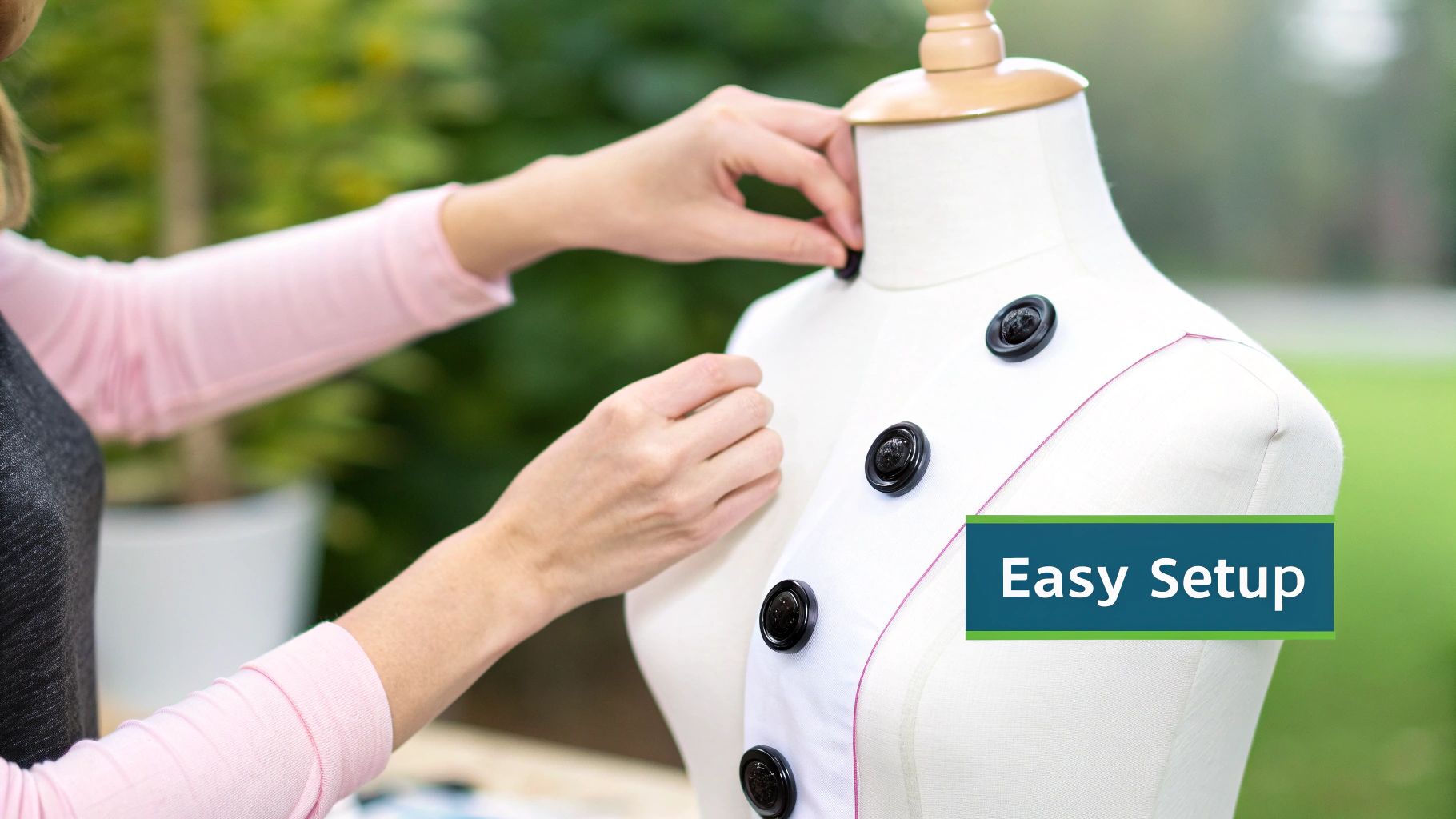
Picking the right adjustable mannequin feels a bit like Goldilocks trying out porridge – not too big, not too small, but just right. It's not about the dream projects swirling in your head, it's about the clothes you actually make. This guide helps you find that “just right” mannequin by taking an honest look at your sewing habits.
Know Your Sewing Self: Skill Level and Garment Types
First, what's your sewing experience? Are you a beginner happily hemming jeans, a confident home sewer tackling trickier projects, or a pro whipping up bespoke designs? A beginner might be fine with a basic mannequin for simple alterations, just like learning to drive in a reliable family car. A professional, though, might need a mannequin with all the bells and whistles for complex draping and pattern making, much like a chef needs specialized knives.
Then, think about the clothes you typically sew. A quilter's needs are vastly different from someone designing evening wear. A quilter might need a stable base for pinning and draping, like a sculptor needs a steady work surface. A dressmaker might need adjustable curves and collapsible shoulders to perfect the fit of a flowing gown.
Space and Budget: Practical Considerations
Your sewing space matters too. A small room can't handle a large mannequin, like trying to squeeze a grand piano into a closet. A compact tabletop model might be a better fit. If you've got the space, a full-torso mannequin offers a more complete fitting solution.
Budget is always a factor. A top-of-the-line adjustable mannequin offers amazing precision, but it’ll cost you. It’s the difference between a basic sewing machine and a computerized model. A budget-friendly mannequin might be perfect for beginners or if you’re watching your spending. Prioritize your needs – maybe something like this UK size 6-8 adjustable mannequin from Display Guru is a good starting point: Check out this adjustable mannequin.
Avoiding Pitfalls: Common Mistakes and Hidden Costs
It's easy to buy more mannequin than you actually need. It's like buying a fancy espresso machine when you really just want a cup of instant coffee. Focus on what you sew now, not your dream projects. Don’t be tempted by fancy features you’ll never use. Look for the essentials: smooth adjustments, sturdy construction, and a stable base. These are the foundation of a good mannequin, like a solid frame for a house.
Don't forget hidden costs like extra covers or stands. It's like buying a car—you need to factor in insurance and maintenance. Regular care, like tightening dials and cleaning, will keep your mannequin in great shape. Think of it like regular servicing for your sewing machine.
To help you navigate your options, take a look at this decision matrix:
Mannequin Selection Decision Matrix
A comprehensive guide to matching your sewing needs with the right adjustable mannequin features and specifications
| Sewing Level | Garment Types | Recommended Features | Budget Range | Top Considerations |
|---|---|---|---|---|
| Beginner | Basic alterations, simple garments | Basic adjustable form, pinnable surface | $50 - $150 | Ease of use, durability |
| Intermediate | Dresses, skirts, blouses, shirts | Adjustable height, collapsible shoulders, markings for darts and seams | $150 - $300 | Versatility, precise adjustments |
| Advanced/Professional | Complex designs, draping, pattern making | Collapsible shoulders, adjustable curves and height, detailed markings, sturdy base | $300+ | Durability, precise adjustments, advanced features |
This table summarizes the key features and considerations for each sewing level, helping you make an informed choice.
By carefully considering your sewing style, workspace, and budget, you can find a mannequin that's your perfect match. It’ll make sewing more enjoyable and help you create beautiful garments. Choosing wisely means your mannequin will become more than just a tool—it’ll be a trusted companion on your sewing journey.
Mastering Your Mannequin: Professional Techniques Made Simple
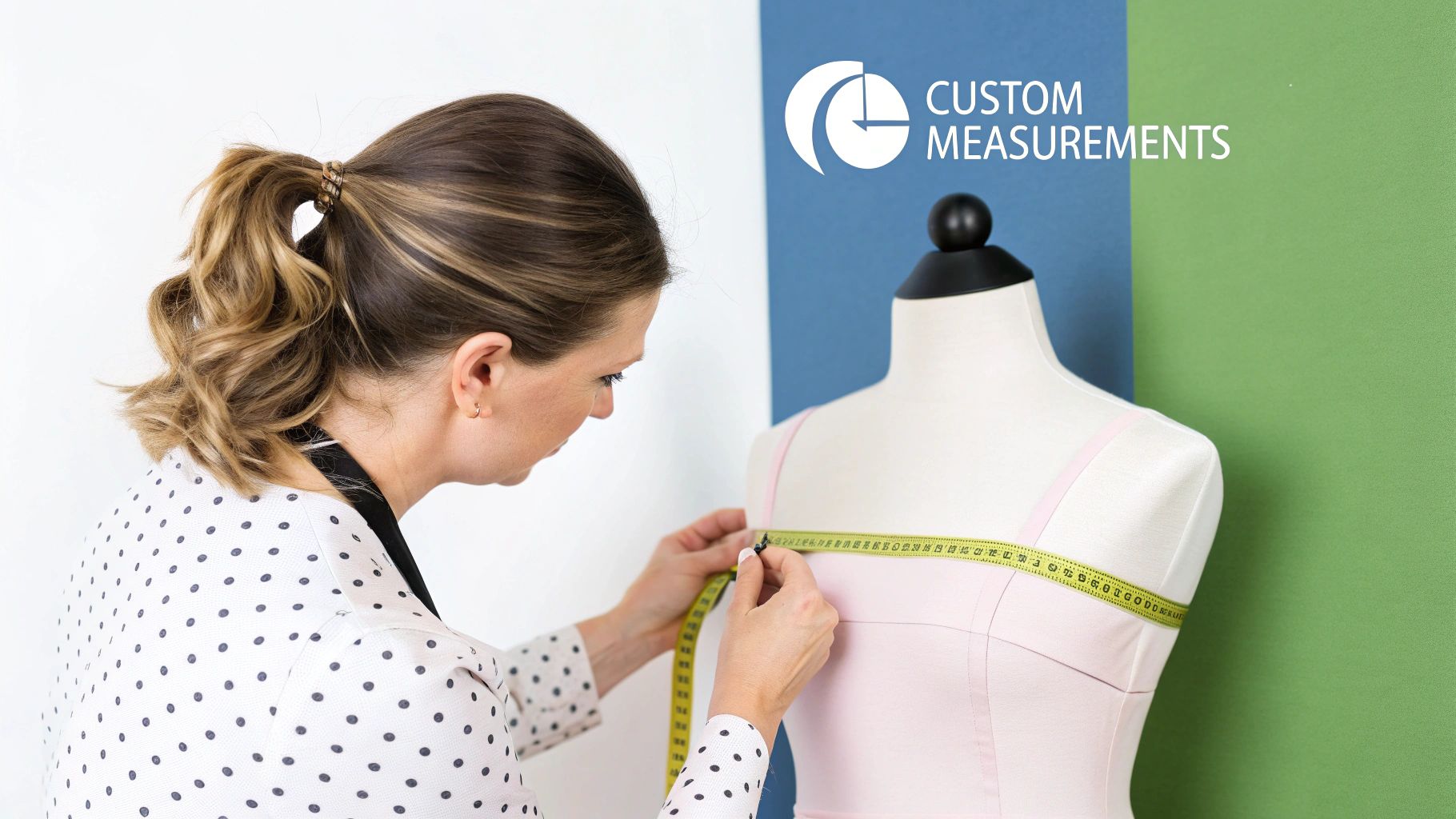
Think of an adjustable dress form as your silent design partner. While it might resemble a simple stand-in, its true power lies in how you use it. Professional dressmakers have a range of techniques they use to get consistent results, and these methods aren't secret knowledge – they're adaptable skills any sewing enthusiast can learn.
Taking and Transferring Measurements: Precision From the Start
Imagine your mannequin as a mirror reflecting your body (or your client's). The key to this reflection being accurate is precise measurements. Start by carefully measuring the bust, waist, hips, and any other relevant areas. Then, transfer these measurements onto your mannequin. This is like calibrating a precision tool – it’s a vital first step.
For example, when creating a fitted bodice, accurately setting the bust circumference on the mannequin is essential for the final shape. Even a small difference can cause fitting problems later. Double-check the mannequin’s measurements against your recorded values with a tape measure. This confirms you’re starting with a perfect base.
Positioning Garments: The Art of Optimal Fit
Placing a garment on a dress form is more than just draping it; it’s about strategic positioning. Think of a sculptor carefully molding clay onto an armature. Similarly, pay attention to how the garment hangs, making sure it sits correctly at the shoulders, neckline, and waist. This helps you visualize the final product and spot any potential fit problems before you even start sewing.
Securely pinning the garment, particularly at key fitting points, keeps everything in place while you make adjustments. Trying to fit trousers on a shifting mannequin is nearly impossible! Pinning keeps the fabric taut, allowing for precise changes and preventing misalignments.
Making Adjustments: Translating Mannequin Fit to Real Life
Adjustments made on the mannequin should translate perfectly to a real body. It's like using a map – the map's accuracy determines how well you reach your destination. When pinning and shaping fabric, visualize how these changes will look on a person. Think about movement, comfort, and how the fabric flows. This allows you to create a fit that is both beautiful and comfortable.
As the UK apparel sector faces increased competition and a rise in imports (clothing imports up 8.75% year-on-year to £1.292 billion and textile imports up 6.91% to £464 million in April 2024), the need for precision fitting tools like adjustable mannequins becomes even clearer. Find out more about the trends affecting UK garment suppliers. These tools provide a critical advantage in a demanding market.
Advanced Techniques: Handling Tricky Fabrics and Designs
As you gain experience, you can start exploring more advanced techniques. For example, draping bias-cut garments needs special attention to prevent stretching. Think of how delicately you would handle silk – its fluid nature requires a gentle touch. Similarly, a mannequin provides a 3D perspective that's invaluable when working with complex designs that have multiple panels or intricate seams.
Learning to use your adjustable mannequin effectively is a continuous journey. Like any skill, the more you practice, the more refined your technique becomes. This hands-on experience elevates your sewing, unlocking the full potential of your dress form. Each fitting becomes an exercise in precision and design, resulting in garments that fit perfectly and showcase your developing skills.
Keeping Your Investment in Peak Condition
Your adjustable dress form is an investment, just like your trusty sewing machine. Treat it well, and it will be your faithful companion for years to come. Neglect it, and you might find yourself facing frustrating problems, like misaligned seams and inaccurate measurements. This means taking care of its moving parts, ensuring its measurements stay accurate, and keeping its structure sound. Let’s delve into the maintenance routines that will keep your mannequin in top form, incorporating advice from both repair professionals and experienced sewers.
Simple Habits for Long-Term Performance
Maintaining your dress form is similar to caring for a good pair of scissors. Regular cleaning and occasional sharpening will keep them working smoothly. The same principle applies to your mannequin. Wiping down its surface regularly with a damp cloth prevents dust and lint buildup, which is especially important for pinnable models. For mannequins with dial adjustments, it's crucial to occasionally check those dials to ensure they operate smoothly and are securely fastened. A drop of sewing machine oil can work wonders on stiff mechanisms. This proactive approach can save you from major headaches down the line.
Imagine trying to adjust your mannequin’s waist, only to find the dial is completely stuck. Regular maintenance can prevent this by addressing small issues before they snowball into bigger problems. Similarly, a wobbly base can throw off your draping and lead to inaccuracies. Regularly tightening the screws will maintain stability.
Spotting Trouble Before It Starts
Just like a doctor can spot the early warning signs of an illness, you can learn to identify potential problems with your adjustable mannequin. With dial-adjustment models, look out for stiff or loose dials, inconsistent measurements, and any difficulty changing sizes. These can all be indicators of wear and tear. For pinnable mannequins, compressed padding, torn fabric, and loose pins are common issues. Addressing these early can often prevent more extensive damage.
Pay attention to how your mannequin feels when you're using it. Does it wobble or feel unstable? Do the adjustments feel smooth and consistent? These subtle clues can often reveal underlying issues before they escalate into major problems.
DIY Fixes vs. Professional Help
Many minor mannequin maintenance tasks can be easily tackled at home. Tightening screws, oiling dials, and patching small tears in the cover are all within the realm of DIY. However, more complex issues, such as broken dials or significant structural damage, might require professional attention. Knowing when to roll up your sleeves and when to call in the experts can save you both time and money.
Understanding your mannequin’s warranty and the availability of replacement parts is crucial. While some manufacturers offer comprehensive warranties and easy-to-find parts, others don’t. Researching this beforehand will protect your investment in the long run. You might find the range of mannequins at Display Guru useful, as they offer options for various needs and budgets.
Protecting Your Investment: Proper Storage and Handling
Proper storage is essential for preserving your adjustable mannequin’s condition. Storing it in a cool, dry place away from direct sunlight will prevent warping and discoloration. This is especially important for plastic and polystyrene models. A dust cover will keep it clean and protect it from accidental bumps and scratches. These simple precautions can significantly extend its lifespan.
Handling your mannequin with care during use also minimizes wear and tear. Avoid using excessive force when making adjustments, and be sure to use the correct pin type for pinnable models to prevent damage. Treat your dress form like the valuable tool it is, and it will reward you with years of reliable service. By following these tips, your adjustable mannequin will remain a trusted partner in your sewing endeavors, providing a consistent and reliable fitting experience every time.
Beyond Basic Fitting: Advanced Applications and Creative Uses
Once you’ve got the hang of using your adjustable sewing mannequin for basic fittings, it becomes so much more than just a helpful tool. It transforms into a true creative partner, unlocking a whole new world of sewing possibilities. This allows you to tackle more challenging projects with a boost in confidence and skill. Both professionals and seasoned home sewers are constantly finding exciting new ways to use these adjustable forms, pushing the boundaries of garment construction.
Draping, Pattern Development, and Alterations: Elevating Your Skills
An adjustable mannequin opens doors to advanced techniques like draping, where you shape the fabric directly on the form to create 3D designs. This hands-on method offers amazing creative freedom, letting you play with folds, gathers, and drapes in a way that’s simply impossible with flat pattern making. Think of it like sculpting with clay—you're molding the fabric on a 3D form, resulting in unique and dynamic designs.
Adjustable mannequins are also incredibly valuable for pattern development. You can test your muslin mock-ups (called "toiles") on the adjusted form, allowing for precise changes and refinements before cutting into your expensive final fabric. This saves you from wasting material and helps ensure a more accurate finished garment. You can easily check how a sleeve drapes or a skirt hangs, making sure it moves and fits exactly how you envisioned.
This image from Wikipedia showcases a variety of dress forms, highlighting their different shapes and how they're made. These forms, though not adjustable, are a basic tool for draping and pattern making. The range of forms in the picture really underscores how important a customizable fitting tool, like the adjustable mannequin, is for accurately capturing unique body shapes.
Alterations become significantly easier and more precise with an adjustable mannequin, too. You can pin and adjust existing clothes directly on the form, getting a clear visual of the alterations in 3D before stitching anything permanently. This is especially helpful for complicated alterations, like tailoring a jacket or reshaping a dress.
Integrating Modern Technologies: A Seamless Workflow
Adjustable mannequins fit right in with modern sewing technology and digital pattern-making software. You can use your mannequin to refine digitally drafted patterns, creating a bridge between the virtual design and the physical garment. This combined approach uses the accuracy of digital tools alongside the tangible feel of working with a 3D form. For example, you could print a pattern, drape it on your mannequin, make adjustments directly on the form, and then transfer those changes back to your digital pattern.
Many sewers also find adjustable mannequins useful for documenting their projects. They take photos and videos for social media or portfolios. The mannequin acts as a consistent and professional-looking display for showcasing finished pieces and demonstrating techniques. This is especially handy for fashion students, designers, and small business owners who need high-quality visuals to promote their work.
Collaboration and Teaching: Sharing Your Skills
Adjustable mannequins can also improve collaboration and teaching. Imagine working with a client on a custom-made garment—the adjustable mannequin allows you to show fitting adjustments and talk about design choices directly on the form. This visual method improves communication and ensures everyone is on the same page about the final product. If you're teaching sewing, an adjustable mannequin lets you clearly demonstrate important concepts like fitting, draping, and alterations.
These versatile tools are constantly evolving alongside sewing practices. New designs and features keep appearing, making them even more practical for a wider variety of sewing projects. This means that a good adjustable mannequin is a wise investment, equipping you for what you need today and future developments in sewing. As you develop your skills and take on more ambitious projects, your adjustable mannequin will remain a key tool in your creative toolbox.
Ready to take your sewing to the next level? Check out the wide selection of adjustable mannequins at Display Guru and find the perfect one for you. They have a variety of sizes, styles, and features to suit everyone from beginners to seasoned pros.
Article created using Outrank
